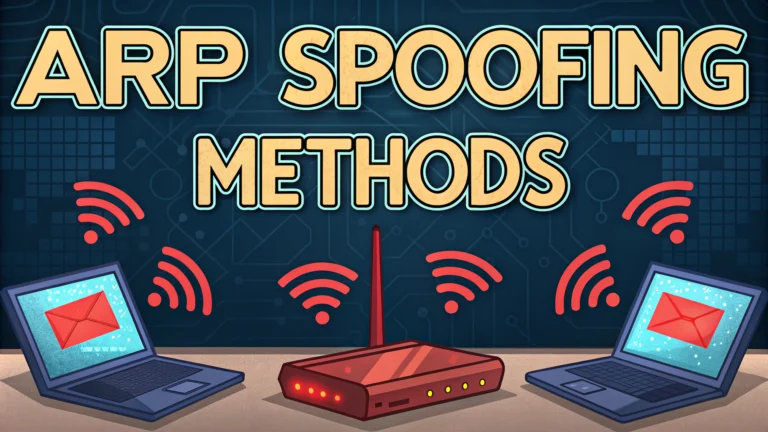ARP spoofing is a network attack that lets hackers intercept traffic between networked devices by manipulating Address Resolution Protocol (ARP) messages.
What is ARP Spoofing?
The attack works by sending falsified ARP messages across a local network to link the attacker’s MAC address with the IP address of a legitimate device like a gateway router.
Common Attack Scenarios
- Man-in-the-middle attacks to intercept data
- Session hijacking
- Denial of service attacks
- Connection interruption
Detection Methods
Network administrators can spot ARP spoofing through these techniques:
- Using packet analysis tools like Wireshark
- Monitoring for duplicate MAC addresses
- Checking for inconsistent ARP replies
- Setting up ARP spoofing detection software
Prevention Techniques
- Implement packet filtering
- Use static ARP entries for critical systems
- Enable VPN encryption
- Deploy DHCP snooping
- Configure port security on switches
Tools for ARP Spoofing Tests
| Tool Name | Purpose |
|---|---|
| Ettercap | GUI-based ARP poisoning and MITM attacks |
| Arpspoof | Command-line ARP spoofing tool |
| Bettercap | Modern network attack and monitoring framework |
Recommended Defense Solutions
- Software: ArpWatch, XArp, AntiARP
- Hardware: Network switches with Dynamic ARP Inspection (DAI)
- Protocols: IPsec, HTTPS, SSL/TLS
Contact your network equipment vendor for specific configuration guidelines related to ARP security features.
Legal Considerations
Only perform ARP spoofing tests with explicit written permission on networks you own or are authorized to test.
Report any discovered vulnerabilities to appropriate security teams or through responsible disclosure programs.
Using these techniques without authorization is illegal and can result in criminal charges.
Risks and Impact
ARP spoofing attacks can have severe consequences for organizations:
- Data theft and information leakage
- Network performance degradation
- Service disruption for legitimate users
- Compromise of sensitive credentials
- Financial losses from business interruption
Incident Response
Immediate Actions
- Isolate affected systems
- Document suspicious ARP entries
- Collect network traffic logs
- Reset compromised network connections
Recovery Steps
- Clear ARP caches on affected devices
- Update network security configurations
- Implement additional monitoring
- Review and enhance security policies
Best Practices
Organizations should maintain these ongoing security measures:
- Regular security audits of network infrastructure
- Employee training on network security awareness
- Updated inventory of authorized devices
- Documented incident response procedures
Conclusion
ARP spoofing remains a significant threat to network security. Organizations must implement comprehensive detection and prevention measures while maintaining vigilance through regular monitoring and testing. Success in defending against these attacks requires a combination of technical controls, user awareness, and proper incident response procedures.
Stay current with the latest network security developments and regularly update protection mechanisms against emerging threats.
FAQs
- What is ARP spoofing and how does it work?
ARP spoofing is a cyber attack where an attacker sends falsified ARP messages over a local network, linking their MAC address with the IP address of a legitimate network device, typically the default gateway, causing traffic to be sent to the attacker instead. - What tools are commonly used for ARP spoofing in penetration testing?
Common tools include Ettercap, Arpspoof (part of dsniff), Bettercap, and Cain & Abel. These tools automate the process of sending spoofed ARP packets and intercepting network traffic. - How can ARP spoofing be detected on a network?
ARP spoofing can be detected through network monitoring tools like Wireshark, monitoring for duplicate MAC addresses, unexpected ARP responses, or using specialized IDS/IPS systems that detect ARP anomalies. - What are the common defensive measures against ARP spoofing?
Defensive measures include implementing static ARP entries, using VLAN segmentation, enabling Dynamic ARP Inspection (DAI) on switches, and deploying network monitoring solutions with ARP spoofing detection capabilities. - What is the difference between ARP spoofing and ARP poisoning?
ARP spoofing and ARP poisoning refer to the same attack technique. The terms are used interchangeably, describing the process of sending falsified ARP messages to manipulate the ARP tables of network devices. - What network protocols are vulnerable to ARP spoofing attacks?
Any protocol running over IPv4 networks using ARP for address resolution is vulnerable, including HTTP, FTP, SMTP, and other TCP/IP protocols operating on local networks. - Can ARP spoofing work across different network segments?
No, ARP spoofing only works within the same broadcast domain or local network segment. It cannot work across different subnets or through routers, as ARP operates only at Layer 2 of the OSI model. - What are the legal implications of performing ARP spoofing?
ARP spoofing must only be performed with explicit permission during authorized penetration testing. Unauthorized ARP spoofing is illegal in most jurisdictions and can result in severe legal consequences. - How does packet sniffing relate to ARP spoofing attacks?
Packet sniffing is often used in conjunction with ARP spoofing, as the attack allows the attacker to intercept network traffic, which can then be analyzed using packet sniffing tools to capture sensitive information. - What is a Man-in-the-Middle attack in relation to ARP spoofing?
ARP spoofing is commonly used to facilitate Man-in-the-Middle attacks by intercepting communications between network devices, allowing attackers to eavesdrop, modify, or inject malicious content into the traffic stream.








